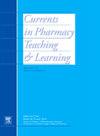Implementation of a peer review process with faculty development in a pre-clinical didactic doctor of pharmacy curriculum to improve exam item quality: Lessons learned
IF 1.4
Q3 EDUCATION, SCIENTIFIC DISCIPLINES
引用次数: 0
Abstract
Background
Exam items can contain unintended flaws that affect validity. Employing faculty development with an exam review panel may help address flaws and improve item quality. We evaluated item quality and perceptions after implementing a peer review process with faculty development in a Doctor of Pharmacy (PharmD) program.
Methods
In this pre-post study, lectures and online modules were developed and shared with faculty to enhance knowledge of best practice for item writing. Course directors recruited peers to review and improve items on summative assessments throughout the didactic curriculum in a PharmD program between academic years 2022–2024. Item quality on summative assessments before and after implementation was evaluated with the National Board of Medical Examination Item-Writing Guide and published checklist. In 2024, item writers, assessors, and course directors were surveyed to evaluate the effectiveness and challenges with the peer review process.
Results
A total of 488 items were evaluated (238 and 250 items before and after the implementation, respectively). The percentage of items with a flaw or an issue was lower by 6 % after the implementation (88.2 % vs. 82.2 %). Twenty-seven out of 32 participants (84 %) completed the survey. Seventy-six percent participated in the training and 64 % recruited peers. Challenges included buy-in, quality reviews, lack of accountability, and time management issues.
Conclusions
When implementing peer review with faculty development across the didactic curriculum in a PharmD program, pharmacy schools may need to develop strategies for faculty buy-in, recruitment and training of quality item assessors and timeline.
在临床前药学博士教学课程中实施同行评议过程以提高考试项目质量:经验教训
背景测试项目可能包含影响有效性的意外缺陷。采用教师发展与考试评审小组可能有助于解决缺陷和提高项目质量。我们在药学博士(PharmD)项目的教师发展中实施了同行评审过程后,评估了项目的质量和看法。方法在这项前期研究中,开发了讲座和在线模块,并与教师共享,以提高项目写作的最佳实践知识。在2022-2024学年的药学博士项目教学课程中,课程主任招募了同行来审查和改进总结性评估项目。采用《国家医学检查委员会项目编写指南》和公布的检查清单对实施前后总结性评估项目质量进行评价。在2024年,项目编写者、评估员和课程主任接受了调查,以评估同行评议过程的有效性和挑战。结果共评估488项(实施前238项,实施后250项)。有缺陷或有问题的项目百分比在实施后降低了6%(88.2%对82.2%)。32名参与者中有27人(84%)完成了调查。76%的人参加了培训,64%的人招募了同事。挑战包括买进、质量审查、缺乏问责制和时间管理问题。当在药学博士项目的教学课程中实施教师发展的同行评议时,药学院可能需要制定教师参与、招聘和培训质量项目评估员和时间表的策略。
本文章由计算机程序翻译,如有差异,请以英文原文为准。
求助全文
约1分钟内获得全文
求助全文
来源期刊

Currents in Pharmacy Teaching and Learning
EDUCATION, SCIENTIFIC DISCIPLINES-
CiteScore
2.10
自引率
16.70%
发文量
192
 求助内容:
求助内容: 应助结果提醒方式:
应助结果提醒方式:


